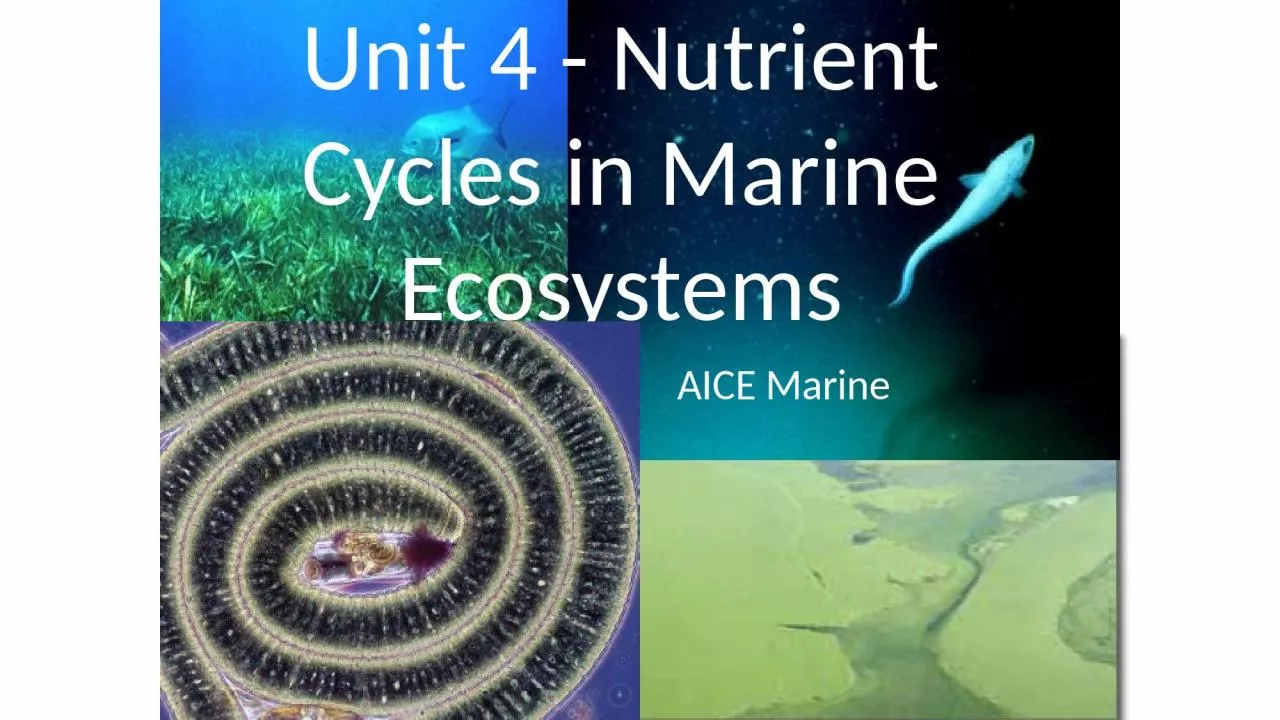

AICE Marine Detritus What is it How does it fit in to a food webchain Whowhat consumes it Detritus What is it Dead decaying organic matter How does it fit into a food webchain ID: 1026725
Download Presentation The PPT/PDF document "Unit 4 - Nutrient Cycles in Marine Ecos..." is the property of its rightful owner. Permission is granted to download and print the materials on this web site for personal, non-commercial use only, and to display it on your personal computer provided you do not modify the materials and that you retain all copyright notices contained in the materials. By downloading content from our website, you accept the terms of this agreement.
1. Unit 4 - Nutrient Cycles in Marine EcosystemsAICE Marine
2. Detritus:What is it?How does it fit in to a food web/chain?Who/what consumes it?
3. Detritus:What is it? Dead, decaying organic matter How does it fit into a food web/chain? Returns nutrients (so they aren’t “lost” from the system)Who/what consumes it? Detritivores AKA Decomposers (fungi & bacteria)
4. Detritus is broken down and released as chemical elements into the soil, water, & air where P.P. can recycle them into organic compoundsWithout detritivores, life would cease! Essential nutrients would be locked up & unavailable to the ecosystem
5.
6. Chemical Cycling:Nutrients move between organic and inorganic parts of the ecosystem in biogeochemical cycles.Cycles may be global or local. Nutrient cycles with a gaseous component (carbon, sulfur, nitrogen) are global whereas phosphorus, potassium and calcium cycle more locally (at least on short time scales).
7. 2 Major Types of Biogeochemical Cycles:**Based on the Primary Source of nutrient input**Gaseous cycles—atmosphere & ocean (global circulation patterns) Sedimentary cycles—soil & rocks of the Earth’s crust; these vary from one element to another, but essentially each has two abiotic phases: Salt Solution phase Rock phase
8. Draw me!Fig. 1
9. Fill me in!Fig. 1
10. General Structure of Nutrient Cycles:Nutrients can move from one reservoir to another by a variety of processesSome examples: Photosynthesis (makes organic nutrients available from inorganic)Respiration (makes inorganic nutrients available from organic)Decomposition (makes inorganic nutrients available from organic)Excretion (makes inorganic nutrients available from organic)
11. Nutrient Cycling: Global ScalePrecipitationUptakeBioelements in solutionWeatheringVolatile bioelements onlyTerrestrial Food WebDecompositionTerrestrial BiosphereDeathDetritusLosses by water runoffVolatile bioelements onlyMarine Food WebDetritusEvaporationH2O (+ volatile biochemicals)SinkingOCEAN*Volatile=evaporates rapidly
12. Decomposition and nutrient cycling ratesRate of nutrient cycling is affected by rate of decompositionIn the tropics, warmer temperatures cause organic material to decompose 2-3 X faster than it does in temperate regions!
13. Decomposition and nutrient cycling ratesIn aquatic ecosystems decomposition in anaerobic sediments can be very slow (50 + years)As a result, sediments are often a nutrient sink and only when there is upwelling* are marine ecosystems highly productive.(*Upwelling is when ocean currents move water vertically from the depths to the surface—more to come)
14. Human effects on nutrient cycles (1):Recent studies suggest that human activities (fertilization & increased planting of legumes) have approximately doubled the supply of nitrogen available to plants.Fertilizers that are applied in amounts greater than plants can use or that are applied when plants are not in the fields leach into groundwater or run off into streams and rivers therefore getting to the ocean.
15. Human effects on nutrient cycles (2):A major problem with intensive farming is fertilizer runoff.The heavy supply of nutrients causes blooms of algae and cyanobacteria as well as explosive growth of water weeds. Because respiration by plants depletes the oxygen levels at night this process of eutrophication can cause fish kills.Eutrophication of Lake Erie, for example, wiped out commercially important populations of fish including lake trout, blue pike and whitefish in the 1960’s.
16. Limits on primary productivityNutrient limitation is a major factor affecting NPP in aquatic biomes.In marine environments the nutrients limiting primary productivity are usually nitrogen and phosphorus, which are scarce in the photic zone.
17. 5 Marine Nutrient Cycles:CarbonNitrogenPhosphorusMagnesiumCalcium
18. Carbon CycleCarbon forms the basis of all organic molecules (organic chemistry is the study of carbon chemistry). Fats, sugars, DNA, proteins etc. all contain carbon.Photosynthetic organisms take in CO2 from the air and using energy from sunlight join carbon atoms to make sugars (energy is stored in the chemical bonds).
19. Carbon CycleMajor reservoirs of carbon include: atmospheric CO2, ocean (dissolved carbon compounds), biomass of organisms, fossil fuels and sedimentary rocks.
20. Carbon CyclePhotosynthesis removes large amounts of atmospheric CO2An approximately equal amount of CO2 is returned to atmosphere by cellular respiration. Burning of fossil fuels adds large amounts CO2 to the atmosphere.
21.
22. Nitrogen CyclingN is an essential element in Protein: each amino acid has at least 1 NNucleic acids: nitrogenous basesN2 makes up about 79% of the atmosphereN2 is only usable by prokaryotes with the enzyme nitrogenaseCyanobacteria like Anabaena carry their nitrogenase in a low oxygen package, the heterocyst.
23. The bacterial processes involved in nitrogen cycling.The width of each arrow is an approximation of the process rate.
24.
25. FixationConverts N2 to ammonia (bacterial)- NH4 : 100 - 200 kg N/ha=90%N2 --> 2N2N + 3H2 --> 2NH3Rhizosphere bacteria: mutualistic, some nodule formersFree-living bacteria (+cyanobacteria) ~ 12,000 speciesNitrate (high energy discharge, like lightning) - NO3NO3 in atmosphere + water vapor = H2NO3Atmospheric fixation low: 8.9 kg N/ha/yr
26. Mineralization (ammonification)Major step in N cycleBiomolecules (proteins,nucleic acids) from dead organisms broken down by bacteria and fungi to amino acids then to CO2 + H2O + NH4 + energyFate: dissolved in H2O, trapped in soil, fixed in clay
27. NitrificationNitrosomonas bacteria use ammonia in soil as sole E sourceNH3 + 11/2 O2 -> HNO2 + H2 + 165 kcalHNO2 -> H+ + NO2Nitrobacter bacteria use the remaining E in nitrite ion and oxidize it to nitrateNO2 + 1/2O2 -> NO3Pollution can result if nitrates build up in aquatic ecosystems
28. DenitrificationNitrates reduced biologically to N2Denitrifiers are facultative anaerobesBacteria: PseudomonasFungi
29. Nitrogen Cycle
30.